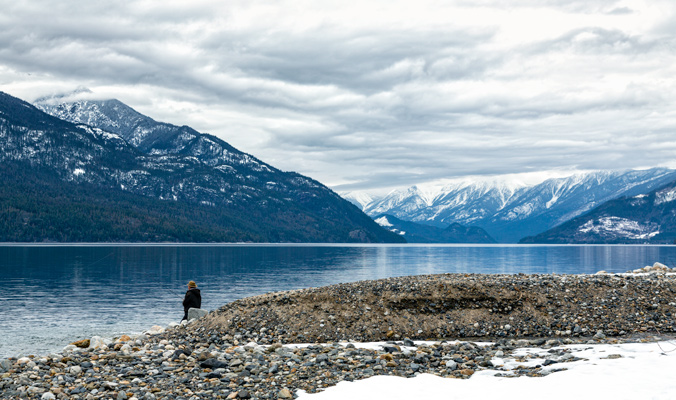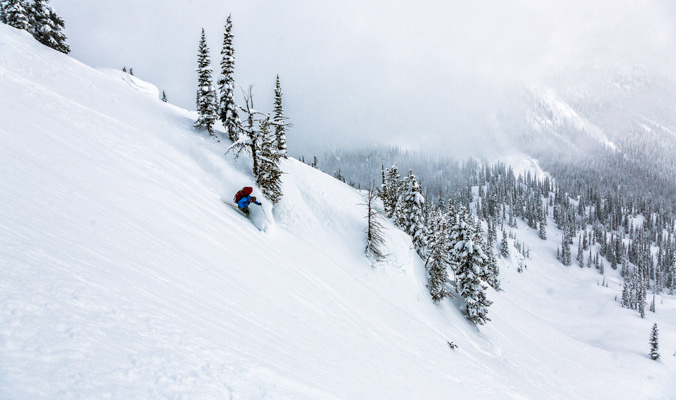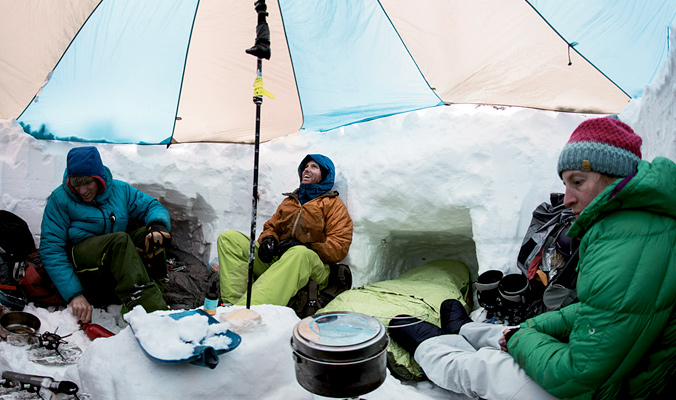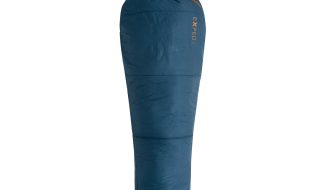
A fisherman angles for a quiet afternoon on the shores of British Columbia’s Slocan Lake. [Photo] Dana Allen
While visiting huts in the Valhalla and Valkyr Mountains, subranges of B.C.’s 200-mile-long Selkirk Mountains that form Slocan Lake’s western border, I’d driven many times along Highway 6, which runs the length of the lake’s opposite shoreline. But until last April, I’d only ever viewed from the windows of a rental car the Slocan Range that parallels the Valhallas on Slocan Lake’s eastern side. For many travelers in search of easy-access lines, the area around Slocan City remains something to view from the driver’s seat, with no hotel and only one gas station in town. But when Hurley reached out with an invitation to tour Kokanee Glacier Provincial Park, we put our faith in his sense of adventure.
Hurley and Monnier moved to Slocan City on the shores of Slocan Lake in 2016 seeking affordable, remote, off-the-grid living and the opportunity to farm in an area where skiing and climbing are still accessible, albeit with a little extra work.

Conor Hurley goes prospecting in his new home range. [Photo] Dana Allen
“You’re surrounded by people who might not necessarily be living off the land, but they have their hands in the ground, and there’s more to life than just skiing, biking and climbing,” Hurley went on to explain after we finished our four-day trip through this remote region. “It’s a flannel and denim kind of community. Some people are into gardening and hacking out a backwoods existence, living on a commune, living off grid. People are working to live.”

Hurley loads up his vintage Mitsubishi Delica in front of his solar-powered home en route to a trailhead drop off. [Photo] Dana Allen
We committed to carrying our glacier travel tools and five days worth of food, and the full weight of our mission hit me in the first few steps on the skintrack: It’s one thing to breeze along a consolidated spring snowpack, but breaking trail for 25 miles through three feet of new snow would slow us down quite a bit. At least I’d have plenty of time to appreciate the solitude of the surrounding mountains.

Hurley (left), brother Patrick (center) and the author take advantage of the insulative properties of B.C.’s deep April snowpack. [Photo] Dana Allen
The first settlers of the area, dating back 12,500 years, were the First Nations Sinixt people who have remained in B.C. despite a 1956 declaration by the Canadian government that they were extinct—a statement that has since been rescinded. Their descendants still have strong ties to this area.
A displacement story of another kind came in February 1942 when the Canadian government authorized the internment of Japanese Canadians at a number of camps throughout the Slocan Valley. In the heart of New Denver, 20 miles north of Slocan City, the Nikkei Internment Memorial Center stands today as a historic landmark of this atrocity.
From the opening of the camps through their 1949 closure, a local community of Russian anti-establishment religious pacifists, the Doukhobors—who were also persecuted by the Canadian government—helped Japanese Canadians integrate into the Slocan Valley. Since the turn of the 20th century, the Russian immigrants have worked closely with the land, evident in the apple trees still growing on Hurley and Monnier’s property, once a Doukhobor farm.
I learned about how the histories of the Slocan Valley have shaped the area’s landscape and culture from Amanda Murphy, Recreation and Cultural Services Coordinator for the town of New Denver, in a phone conversation after returning home. During our chat, Murphy summarized the role persecution has played in creating the Slocan Valley of today.

Dominique Monnier, Patrick Hurley and the author skin through a recent burn, a reminder of the passing of old and rise of new industries in the Slocan Range. [Photo] Dana Allen
An economy based around resource extraction, which started with mining in the early 1890s, existed in parallel with these immigrant communities. The discovery of lead ore, dubbed galena, in the Selkirk Mountains outside of what would become the town of Sandon, kicked off the mining boom. By the late 1890s, towns had sprung up along Slocan Lake, including New Denver, Silverton and Slocan City, brimming with people looking to make their fortune. In Sandon, the location of the Slocan Star mine, the population in 1900 reached around 5,000 people, but in a little over a decade, that number dipped to fewer than 1,000 due to fire, mining strikes and Alaska’s Klondike Gold Rush, which drew prospectors farther north.
A short drive up the access road that spits off Route 31A to cat-ski operation Retallack provides an in-person view of Sandon, the mining ghost town once referred to as “Paris of the West.” Throughout the Slocan Mountains, exposed bones of mining shacks serve as a reminder of how quickly plans and circumstances can change here.
Our group took a lesson from history after our first day in the skintrack. Sitting in a five-person snow cave topped with a tarp, we discussed a change of itinerary. After making it only six kilometers, we stared in the direction of Arlington Peak with its flanks boasting progressively deeper snow cover, and our plans to traverse changed to plans to shred.

The author takes advantage of a lighter pack to mine turns on the slopes of Arlington Peak. [Photo] Dana Allen
“I knew the quality of the skiing, and I always thought it would be cool to explore [around Arlington Peak], but, because of work, I never got the occasion,” he said.
“I’m sure people go skiing back here, but you still get the sense that it’s pretty untraveled by ski tourists,” Monnier added. “You feel like an explorer.”
In this region, ski infrastructure, even of the backcountry kind, is sparse. A 50-minute drive from Slocan City down Highway 6 through New Denver toward Kaslow passes by Retallack, the area’s largest developed ski destination that employs a number of Slocan Valley residents. One such resident, Walter Dagostini, lives on the plateau above New Denver. An employee of the Ruth Mine in Sandon for 15 years before it closed in 1995, Dagostini now works as a tail guide and custodian for Retallack.
“[Mining] was just a job; it was a good job, and there were close to 40 or 50 people employed at the mine at the concentrator,” Dagostini remembered on a phone call I made after receiving a tip-off from another Slocan Valley resident about his multifaceted work history. “It was one of the major employers in the area—[New Denver] was a busy little place in the ’80s, but things just shut down when the mine closed. I stayed and started lawn-mowing and house-painting work. Then I got involved with Retallack in 1996.”

Hurley identifies the Kokanee Glacier Provincial Park traverse, later to be scrapped in favor of powder laps. [Photo] Dana Allen
“I’m the connection to the past with all of those young Retallack people,” Dagostini said. “I can talk to them about the history of the area, about the mining that I did.” And for the growing recreation economy, he explained, “The potential here is huge and untapped. We don’t have the big resort-style hotel here, but we have the class-A wilderness park in the Valhallas.” He also reiterated Hurley’s sentiment that life in the Slocan Valley is more about loving a place than about pushing through the daily grind. “Jobs are scarce,” he said, “and you might be running two part-time jobs to live here instead of one full-time job.”
It’s that non-conformist lifestyle that draws in people who are willing to get creative to make a living in Slocan’s secluded setting. Annie Strucel—a 25-year resident of Nelson, B.C. and chef for numerous hut trips I’ve been on in this region—spends the majority of her winter months cooking at Slocan Valley backcountry huts to earn her keep while still hitting the skintrack for multiple hours each day.
“I choose to do this kind of work because I need creativity and flexibility,” Strucel explained on a midsummer phone call before leaving for her warm-weather gig as a chef on a sailboat in Alaska and on the B.C. coast. “Working in the Slocan Valley at Valhalla Mountain Touring is that place for me.”

The crew returns home—but remains off-the-grid for the celebration of an unprecedented April snowfall. [Photo] Dana Allen
I could relate to that feeling of isolation as we slowly skinned up Arlington Peak on our way home, the noise of the wind blocking even conversation among our group. The threat of that unseasonable snowstorm turning to more predicable heavy rain forced us to return to civilization a day early. But it had been worth the work to experience the mountains of the Slocan Range, even if it meant carrying a heavy load.










Walter’s nickname is Trammer. He used to be the guy who would push the tram cart out the mine to dump the overburden and ore. He’s such an incredible personality to talk to- a fixture of the valley!